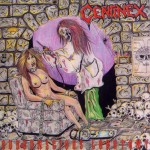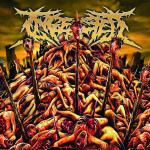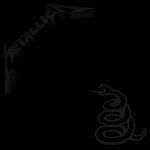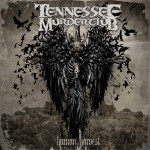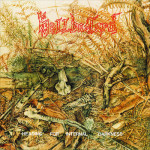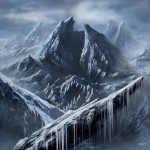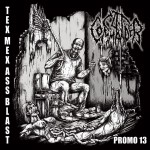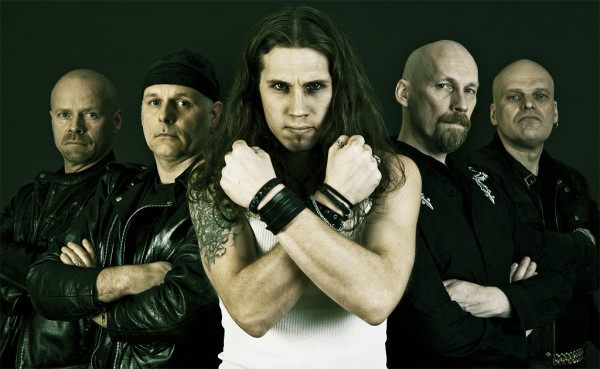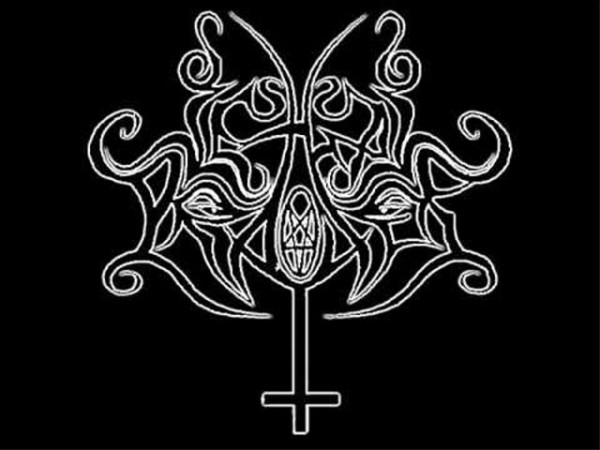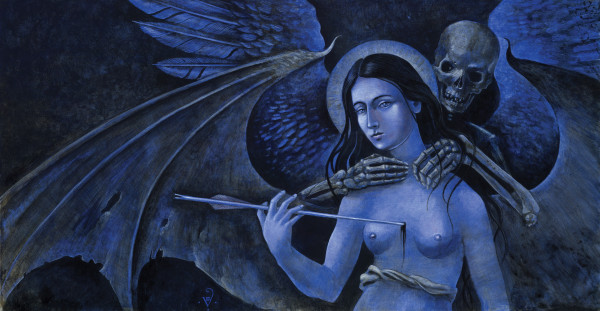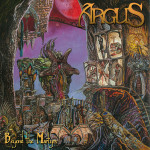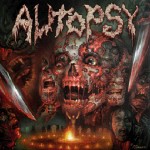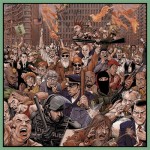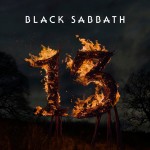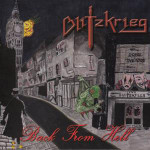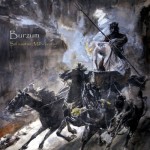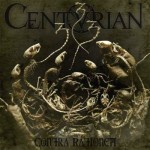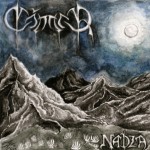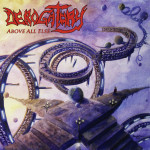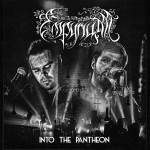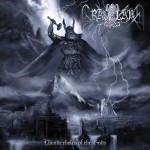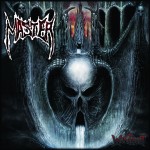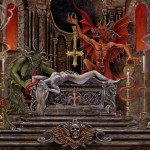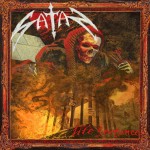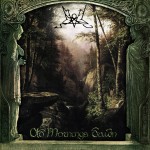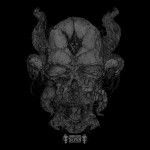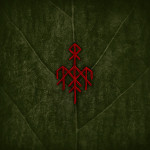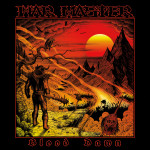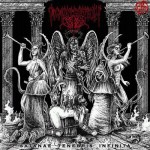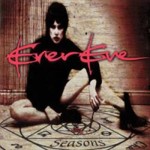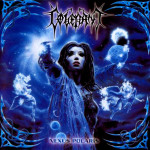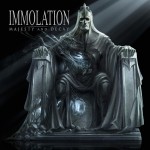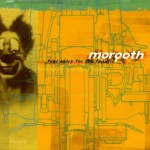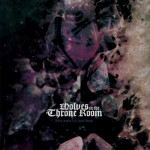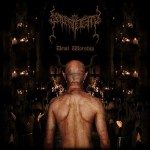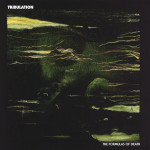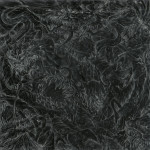
Steve Cefala (R) and Birdo (L) of Dawning.
Welcome to the strange and protean world of Steve Cefala, black/doom metal musician, MMA fighter, former adult entertainment actor, and now, the force behind the returning Dawning and its unique brand of slow melodic metal with horror movie keyboards.
Dawning was born in 1996 at the hands of Mr. Cefala and a close cadre of collaborators. Dormant for many years, but never forgotten, the band was resurrected with the – – –/Dawning split that showcased a classic song for the band and gave it new arrangement and orchestration.
We were lucky to catch up with Mr. Cefala between his many high-energy ventures and get in a few words about the split, the history of Dawning, and its future both as band and concept.
When did Dawning form?
Bud Burke (now in Exhumed) and I quit Pale Existence and started Dawning in 1996. Bud and I may have done some rough Dawning recordings on his four track as early as 1995. We were juniors in high school. We had just terrorized the high school battle of the bands with our cheesy Satanic side project Desecrator (there’s so many bands called that).
Why do you think Dawning is less known that other bands from the era?
First, although not many people know about Dawning, the people I know of that like Dawning are people I respect.
But there are several reasons for Dawning’s relative obscurity. Some are obviously self-inflicted: personnel/lineup problems and changes, lack of self-promotion, etc. We were more focused on making good music and recording it than on the promo side. Also not fitting an exact genre or lack of other doom/black metal bands locally at the time did not help.
We also had offers to be published by record companies which we messed up. As we were about to record for a 10″ release, the incredibly talented bassist who was the band’s contact had a breakdown from acid and thought he was an alien… and the other guitarist Mike Rabald turned super flakey and just would not record his darn guitar tracks, despite being at the recording studio drinking ale and playing Sega Genesis every day instead! After months of that B.S., when we finally threatened to kick him out, he and the sound engineer showed up at my front door demanding cash for what we had recorded so far or they would to destroy the reel! Prick…..
For some reason, we just could not get a show at this period in time. This pissed me off because I was the first metal guy to rent the local library out and throw many underground DIY metal shows and I had set up a lot of shows for local bands with my previous band Pale Existence. Some ugly heifer from my high school ended up renting the library out and getting metal shows banned from the library due to burning bible, blood spills, and setting off fire alarms. Way to go! I also threw a lot of shows for Exhumed and a bunch of local acts at the Cupertino library. They are cool guys but they never reciprocated because we were not gore metal (I remember them helping out Gory Melanoma a lot with shows for instance) or would not kiss their ass or something. Drummer Brian and I used to tease them about them being Carcass rip offs and Matt Harvey being Mr. Rockstar. Anyways, the library shows I threw were integral in bringing the South Bay death metal scene together. They were free all ages DIY shows that united a bunch of different metal and hardcore genres.
It’s also not like people didn’t know we were available. Dawning got only three shows! The KFCJ radio show, one at a frat party in SLO, one in a gazebo teen center I rented. This was despite that I had a full band lineup from 1996-2003! A third show was set up in an alley in Gilroy and the club owner canceled the show at like 7 pm (Maelstrom was headliner) before metal heads, who showed up later like 8, could get the message.
I would mention some other excellent local bands from that era which may have been forgotten includes Gory Melanoma, Infanticide, Butt, Agents of Satan, Deity, Disembodiment, Doomed-horn, and Gorgasm! :) I am glad to see that Morbosidad is still active also :)
Originally, what did Dawning sound like — what was the intent, and what were the influences, behind the sound you were going for?
The sound I have always aimed for with Dawning is to take a synthed out movie soundtrack and cross it with raw doom or black metal guitars and vocals. With a hint of ambient (backwards vocals, chimes, timpani drums). The end of the first demo has a incredibly slow doom ending with a collage of apocalyptic samples. When I started recording this shit back in 1996 I didn’t hear anyone grinding black metal guitar chords over a doom beat. I still barely ever hear that. I guess all the black metal bands are playing doom and ambient now mostly — at least the ones who aren’t constantly blasting as if they are at some type of competitive track meet event.
“New” Dawning sounds basically exactly like original Dawning. It’s all written on the Roland JV series keyboard mostly. There were some demos we did that trended more towards black metal, and some had hippy elements.
Our influences include movie sountracks like Goblin, Angelo Badalamenti (Twin Peaks), John Carpenter scores, Vangelis, Jerry Goldsmith (the Omen), etc. as well as classic 90s doom and black metal — Winter, Disembowlment, Grief, Marduk, Darkthrone, Impaled Nazarene, and My Dying Bride. There is also some trance influence from raves and partying. On the hippier demos there’s a Hendrix and Sabbath vibe to the guitars at times.
Also, Dawning has goth/industrial influences. I listen to Godflesh, Rammstein, Depeche Mode, My Life With The Thrill Kill Cult, Type O Negative, etc.
How did that sound change over time?
- Demo 1 – Blackened doom/new age-ish (hint of ambient). Just Bud and I, no bass.
- Demo 2 – Live on KFJC. Groovier. More Hendrixy and more Sabbathy. Full band lineup starting with this demo. Trippier more occult-based song themes. Bouncy hippy basslines.
- Demos 3 and 4 – More black metal. Less doom.
- Demo 5 – Exit Bud Burke, enter Mike Beams (Exhumed). More brutal and detuned. Added elements of sludge doom.
…then back to the original sound of demo 1 again for the split. The upcoming full length is like demo 1 but with more mid-paced grooves and a few blasts besides the doom beats.
You’ve re-recorded “Divine Arrival of the Massive Hoof” for the split with – – – on Preposterous Creations. How did this split come about, and what’s new with the re-recording?
I hooked up with Phil from Presposterous Creations on a web forum where he had posted some old Dawning demo links. I was told Gary from Noothegrush (who actually recorded our live at KFJC demo back in the day) helped get Phil interested in Dawning. Chiyo and Gary (from Noothegrush) have always been most supportive of my band. I honestly think Dawning might not exist today if not for them. And I was told that John Gossard (Weakling) had also talked to Phil about us, which helped. Originally Bud was planning to come out on vacation to visit and record on the new tracks with me. But Exhumed called him and off on tour he went. Now he doesn’t return my calls or lousy Facebook messages even.
“Divine Arrival of the Massive Hoof” on the split has a new arrangement. Better recording. Also, there was a period during these most recent recordings where I was diagnosed as allergic to sunlight. This time was depressing and that gave the songs a darker tone.
A couple of years ago I noticed there was something called the “101 Rules of Black Metal” going around the internet (you can google it). I noticed a rule saying that “the exact date if the divine arrival of the massive hoof shall never be revealed under any circumstance.” It even made it on the Ozzfest official page at that time. I was a little surprised that phrase was ingrained as a rule of metal (I see no other song title as a rule — but I could be wrong). I will admit that I did want to get some credit for the notoriety of the song I had created in 1995-96 and that was part of my motivation in redoing the song and getting it published. I am extremely thankful to Phil and to Noothegrush and the handful of people including John Gossard who kept the spirit of Dawning alive on underground message boards and such. Also whoever put it in the rules of metal I am thankful but would have been better had Dawning been given proper credit.
What’s – – – like, in your words? What was the appeal in working with them?
As far as actually splitting the record with – – – , it was Phil who came to me with this idea. Personally I find the piano parts on all – – – songs to be very inspired and unique and I also love his guitar tone (it reminds me of early Ulver!). So I was honored to split the LP with – – –, though I know nothing about them it is an honor to be associated with that level of talent.
Do you think metal is in a slump, or a time of over-abundance? Are there any parallels to humanity at large?
I do not like the overall musical trends in metal. Blast beat blast beat blast beat. Hail Satan this, hail Satan that. Blast beat blast beat blast beat. Blah blah blah. Playing drums like a track meet competition.
Most of the Gothic doom bands seem really gay (not in a happy sense though) compared to My Dying Bride, at least locally. Stoner bands who are not stoney — or original. Technical death metal which gives me a headache. I also don’t like the super mainstream bands right now like Lamb of God.
Nachtmystium and Electric Wizard and a few other amazing bands in the mainstream (I enjoy Noothegrush, Ludicra, and Weakling) but there’s too much crummy bands you have to go through to find a good one. Compared to the 90s — it sucks!
Locally I fell into the boring status quo sound a little too much with my last band Condemned to Live (DJ) for a few years so I must also take my share of this blame.
And yes humanity stinks too. Pretty much everything stinks these days honestly. I stopped listening to Marduk and Vader, and then Fear Factory and bands like that when they put out that pseudo techno album in the late 90s.
Also when you play a show these days its often a pissing competition between the bands instead of a brotherhood of metal. The other bands come up to you and complain about the band order instead of introducing themselves. Or you could be informed that another guy in the other black metal band that night does not like your band etc I was playing black metal live when he was in kindergarten but hey whatever…
In the 90s we knew we were all social rejects and we bonded over that. Today these kids who grew up in a post 9-11 world live in a darker cutthroat worldview. 90s metal tended to have some sense of humor that is now absent by in large. I think the global economic depression has caused metal to lose its fun fantasy oriented spirit that it had before. By the way outside a few dive bars here like the Caravan, metal is so unpopular where I live in San Jose — everything is gangster rap this, gangster rap that. I can go out for a whole week and maybe see one metal tshirt. Funny thing is my gangster friends like Dawning and are supportive.
What do you think are the differences between black metal, doom metal and regular old heavy metal?
Honestly, it’s all over genre-ized. I honestly wouldn’t even mention my bands genre but I feel strongly we were ahead of our time and deserve a little credit, even if its just a tiny bit. Everyone is mixing black metal and doom now. Back then I heard maybe one Incantation album that did that a bit, not much else.
I can tell you locally while I respect the underground hardcore approach of many bands — mostly everyone just wants to be a genre guy and fit in, which is sad cause metal ain’t even popular in the US in mainstream pop culture so these days why worry about fitting in.
It’s sad to me. Oh well. When I talk to other musicians these days its “Hey, I like this one band, Electric Funeral — let’s do a band like that” or “Hey, I like this band Cradle of Filth lets do one of those!” Nobody wants to make their own band sound. It’s much easier to join a specific genre, follow that genre’s rules to the T, and network from just within that genre. That’s my main problem with modern metal. Of course there are exceptions.
Is Dawning back on the warpath? Will we hear more in the coming weeks, months and years?
I create the music of Dawning for myself and for the chosen few who are willing to listen to what Dawning has to offer them. To those who will listen we offer an escape to another another dimension in which their imagination can run free.
While I have been trying to get the band going live, at this point I am tired of auditioning show-off types and have taken matters into my own hands. I am currently playing electronic drums while at the same time playing keyboards on with my other foot (Moog Tarus clone). My right hand also plays some keyboards. So I am playing drums and keyboards; the drums are electronic, so I feel like I am piloting a spaceship when I am playing I can be in my own world. Also I am not a great drummer, but I can keep the beat.
My girlfriend Charity has taken over on bass guitar for now. She has named herself Nubian WitchGoddess (is that one taken?) and I am working with a guitar player named Gabriel. If this lineup works out we will be performing very soon. The Caravan has always been supportive and said we can play anytime. Noothegrush expressed willingness to play the tiny club with us eventually, which was very nice of them. Also I personally have an entire band’s worth of equipment including every instrument and amp and drums and PA etc., so let it be known I have 100% been trying to take Dawning live for the last year or so and basically have received little to no support from local musicians in this effort. I have had many ads out with few responses. And, funny, what do you know — now that the record came out like 10 people just contacted me all of a sudden about joining. Way of the world I suppose!
There is a full length album I finished recording coming out on cassette in a few months on French label. It has some more upbeat black metal stuff but plenty of doom too. It flows. The new full length album is about the Satanic albino cult that lives high in the hills above Silicon Valley, by the way. My car broke down up there many years ago and the Sherrif told me about them and gave me gas to get the fuck out of there.
http://www.youtube.com/watch?v=u82y93yi7Ng
24 CommentsTags: Black Metal, dawning, Doom Metal, steve cefala
